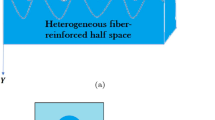Abstract
A new method of producing accurately controlled bond ratios in weakly bonded composites was developed to investigate the influence of adhesive porosity on mechanical properties of the bondline. The ultrasonic A-scan was used to detect weak bonds in adhesive joints and the ultrasonic A-scan signals of weak bonds were analyzed to link with adhesive porosity. As well, relations of adhesive porosities to four-point bending (4PB) were established based on experimental and numerical results. It was found that the amplitudes of amplitudes of A-scan signals of the adhesive interface are approximately linear functions of the bond ratios, as well as the adhesive porosities. The shear strength of bondlines decreases linearly with the bond ratios. Based on above results, properties of weak bonds could be evaluated by the UT (Ultrasonic Test) signals, which is of great value in engineering application.
Similar content being viewed by others
References
A. Higgins, Int. J. Adhes. Adhes., 20, 367 (2000).
C. C. H. Guyott, P. Cawley, and R. D. Adams, The J. Adhes., 20, 129 (1986).
K. B. Katnam, L. F. M. Da Silva, and T. M. Young, Prog. Aerosp. Sci., 61, 26 (2013).
G. Mancusi and F. Ascione, Compos. Struct., 96, 256 (2013).
Y. Liu, J. Johnston, and A. Chattopadhyay, doi: https://doi.org/10.1115/IMECE2013-65767, 2013.
J. Alston, A. Croxford, J. Potter, and P. Blanloeuil, NDT and E Int., 99, 105 (2018).
C. Yang and J. S. Tomblin, “Investigation of Adhesive Behavior in Aircraft Applications”, http://rgl.faa.gov. (Accessed October 6, 2020).
S. Pantelakis and K. I. Tserpes, Science China Physics, Mechanics and Astronomy, 57, 2 (2014).
C. Brotherhood, B. Drinkwater, and S. Dixon, Ultrasonics, 41, 521 (2003).
K. Vine, P. Cawley, and A. Kinloch, J. Adhes., 77, 125 (2001).
I. Y. Solodov, Ultrasonics, 36, 383 (1998).
B. W. Drinkwater, R. S. Dwyer-Joyce, and P. Cawley, Review of Progress in Quantitative Nondestructive Evaluation., 16, 1229 (1997).
J. Bardis and K. Kedward, “Effects of Surface Preparation on the Long-Term Durability of Adhesively Bonded Composite Joints”, http://rgl.faa.gov (Accessed October 6, 2020).
J. S. Tomblin, C. Yang, and P. Harter, “Investigation of Thick Bondline Adhesive Joints”, http://rgl.faa.gov (Accessed October 6, 2020).
C. Yang, J. S. Tomblin, and Z. D. Guan, “Analytical Modeling of ASTM Lap Shear Adhesive Specimens”, http://rgl.faa.gov (Accessed October 6, 2020).
M. Michaloudaki, E. Lehmann, and D. Kosteas, Int. J. Adhes. Adhes., 25, 257 (2005).
C. Meola and G. M. Carlomagno, Meas. Sci. Technol., 15, 27 (2004).
R. B. Heslehurst, J. P. Baird, and H. M. Williamson, J. Adv. Mater., 26, 11 (1995).
R. B. Heslehurst, Int. J. Adhes. Adhes., 19, 133 (1999).
J. M. Baik and R. B. Thompson, J. Nondestr. Eval., 4, 177 (1985).
P. B. Nagy, J. Adhes. Sci. Technol., 5, 619 (1991).
R. D. Adams and W. C. Wake, “Structural Adhesive Joints in Engineering”, pp.309–313, Elsevier Applied Science Publishers, London and New York, 1984.
P. Y. Wang, Z. C. Li, L. C. Zhou, and Y. M. Pei, Compos. Sci. Technol., 162, 117 (2018).
J. L. Rose, “Adhesive Bonding”, p.425, NewYork, NY: Plenum Publishing, 1991.
M. Michael, J. G. Capetta, and A. H. Davidoff, “Nondestructive Characterization for Advanced Technologies”, p.132, Columbus, OH, The American Society for Nondestructive Testing, 1991.
K. Smith, “Bonded Joints and Structures-Technical Issues and Certification Considerations”, http://rgl.faa.gov. (Accessed October 6, 2020).
M. D. Banea and L. F. M. Da Silva, Proc. IMechE Part L-J Mater Design Appl, Vol. 223, p.1, 2009.
C. Jeenjitkaew, Z. Luklinska, and F. Guild, J. Adhes., 87, 291 (2011).
C. Jeenjitkaew, Z. Luklinska, and F. Guild, Int. J. Adhes. Adhes., 30, 643 (2010).
T. Zhang, J. Meng, Q. Pan, and B. Z. Sun, Compos. Commun., 15, 87 (2019).
ASTM D 7264, “Standard Test Method for Flexural Properties of Polymer Matrix Composite Materialss”, America; Annual Book of Standards, 2007.
ASTM D5528, “Standard Test Method for Mode I Interlaminar Fracture Toughness of Unidirectional Fiber-Reinforced Polymer Matrix Compositess”, America; Annual Book of Standards, 2013.
ASTM 2344, “Standard Test Method for Short Beam Strength of Polymer Matrix Composite Materials and Their Laminates”, 2000.
Henkel, “Loctite EA 7000 Aero Epoxy Film Adhesive data sheet”, https://www.pccomposites.com (Accessed May 1, 2020).
X. Li, D. Dissertation, University of Bristol, 2009.
Acknowledgements
The financial support provided by the Science and Technology Commission of Shanghai Municipality, China through the grant No. 19DZ1100300 and No.18DZ2204600, the Fundamental Research Funds for the Central Universities of China through Grant No.2232019G-02 to the work presented here are gratefully acknowledged.
Author information
Authors and Affiliations
Corresponding author
Rights and permissions
About this article
Cite this article
Zhang, T., Li, X. & Chen, L. Linking UT Signals to Properties of Weakly Bonded Composites by Four-point Bending Test. Fibers Polym 23, 791–799 (2022). https://doi.org/10.1007/s12221-022-3191-7
Received:
Revised:
Accepted:
Published:
Issue Date:
DOI: https://doi.org/10.1007/s12221-022-3191-7




